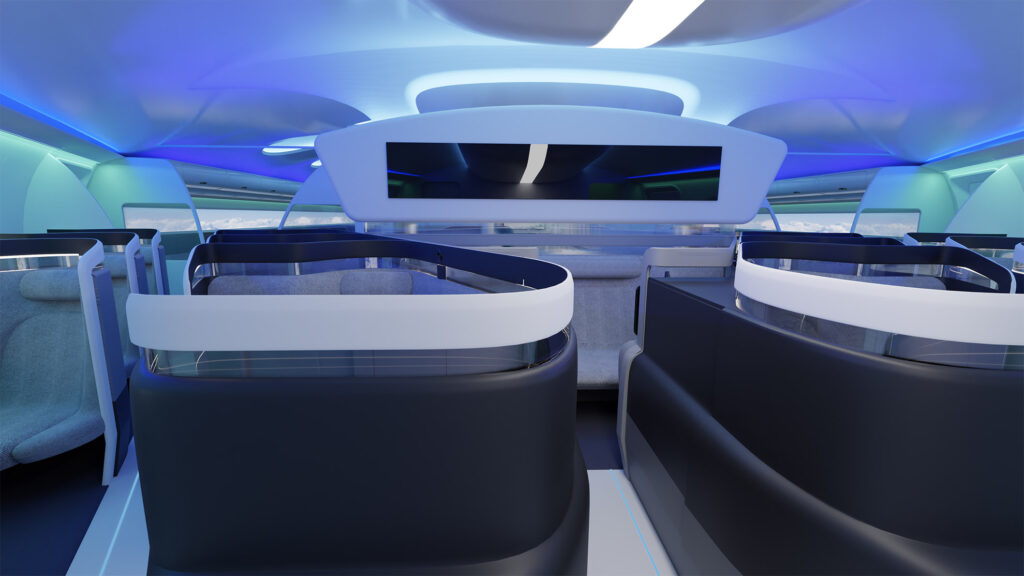 Variations of blended wing body (BWB) aircraft have been studied for decades. And in more recent years, NASA, Airbus, KLM, the Delft University of Technology and other industry stakeholders have sought to advance various BWB ideas. Now a former McDonnell Douglas program manager, Mark Page — who in the 1990s led a three-year NASA funded initiative to explore BWB properties — is working with other industry veterans with the intent of bringing a viable BWB aircraft to market.
Variations of blended wing body (BWB) aircraft have been studied for decades. And in more recent years, NASA, Airbus, KLM, the Delft University of Technology and other industry stakeholders have sought to advance various BWB ideas. Now a former McDonnell Douglas program manager, Mark Page — who in the 1990s led a three-year NASA funded initiative to explore BWB properties — is working with other industry veterans with the intent of bringing a viable BWB aircraft to market.
The company is California-based startup JetZero. Co-founded by Page, who serves as CTO, and CEO Tom O’Leary, JetZero believes its BWB design will be nothing short of “revolutionary” for commercial aviation, delivering up to 50% better fuel efficiency than today’s mid-market airliners.
“Traditional tube-and-wing planes have reached the end of the road on efficiency gains. We also face a new era of steep increases in fuel cost. That’s why starting with an airframe that cuts fuel burn and emissions in half is the best first step for sustainable aviation,” says the firm.
Initially, the BWB aircraft will fly using traditional jet fuel or sustainable aviation fuel (SAF). However, JetZero says it is well suited for adaptation to zero-emissions hydrogen propulsion in the future.
 JetZero’s design allows the BWB aircraft to serve multiple missions including as a freighter, tanker or jetliner. According to Aviation Week, JetZero’s mid-market jetliner, the so-called Z-5 design, will offer a range of up to 5,000nm and can seat up to 250 passengers.
JetZero’s design allows the BWB aircraft to serve multiple missions including as a freighter, tanker or jetliner. According to Aviation Week, JetZero’s mid-market jetliner, the so-called Z-5 design, will offer a range of up to 5,000nm and can seat up to 250 passengers.
As JetZero’s work progresses, much attention will be paid to the aerodynamic fuselage shape of the BWB, and indeed the firm’s choice of engines — which will be positioned above the aircraft in semi-buried engine nacelles — as well as the avionics and other key hardware.
But because the BWB aircraft is effectively one huge wing, it provides greater internal volume in the cabin, offering new possibilities for the passenger experience.
That’s why, since late 2021, JetZero has been working in stealth mode with celebrated London-based design house Factorydesign to evolve the new BWB cabin interior design.
Today, Factorydesign shared with Runway Girl Network some renderings of its joint collaboration with JetZero.

 “The interior of the JetZero aircraft has been inspired by regenerative design principles, more commonly used in ultra-modern building design, therefore material is there to provide strength where it’s needed and cellular gaps appear where it’s not, saving weight,” say the two firms in a published statement.
“The interior of the JetZero aircraft has been inspired by regenerative design principles, more commonly used in ultra-modern building design, therefore material is there to provide strength where it’s needed and cellular gaps appear where it’s not, saving weight,” say the two firms in a published statement.
They explain that this innovative approach means the cabin can be lit by overhead and front side windows, with many apertures in-between the structural elements that flood the cabin with light and space.
In the multiple seating areas positioned within the center of the aircraft, the latest hi-definition screens could form sidewalls allowing projection of either window frames with a view, or full length, animated panoramic views of the passing sky.
 While the renderings show rather standard seating products on board, including the sort of economy and business class platforms seen on single- and twin-aisle aircraft today, JetZero and Factorydesign assure there is ongoing activity to “completely redefine” the commercial passenger flying experience, noting, for instance, that the interior space allows designers more flexibility in working with airlines on their preferred galley, lavatory, and seating arrangements.
While the renderings show rather standard seating products on board, including the sort of economy and business class platforms seen on single- and twin-aisle aircraft today, JetZero and Factorydesign assure there is ongoing activity to “completely redefine” the commercial passenger flying experience, noting, for instance, that the interior space allows designers more flexibility in working with airlines on their preferred galley, lavatory, and seating arrangements.
“The blended-wing shape offers a unique opportunity to move past the space constraints of tube-and-wing aircraft, raising the bar for passenger and crew comfort. We are delighted to have Factorydesign on-board to help JetZero create a future flying experience that passengers will love,” says JetZero’s O’Leary.
 Factorydesign director Peter Tennent adds: “Aircraft technology has advanced hugely over the last 60 years, however, the opportunities for improved efficiency are reducing.
Factorydesign director Peter Tennent adds: “Aircraft technology has advanced hugely over the last 60 years, however, the opportunities for improved efficiency are reducing.
“The same is happening in cabin interiors as decades of attention means opportunities in tube and wing aircraft to create unique passenger experiences are becoming increasingly elusive. Significant and beneficial step-change to the passenger flying experience will only come with a revolution in aircraft, and the JetZero blended wing aircraft is exactly that.”
 JetZero also reckons that its new approach meets the growing demand for more environmentally sustainable aircraft, as the blended wing is naturally stable and generates lift across its entire span.
JetZero also reckons that its new approach meets the growing demand for more environmentally sustainable aircraft, as the blended wing is naturally stable and generates lift across its entire span.
“With reduced surface area and weight, less power is required — a virtuous circle leading to less fuel consumption, lower operating costs, and lower emissions to meet industry’s commitment to net zero emissions by 2050,” it says.
The company is already engaged with commercial airlines and freight companies. Moreover, it says, the US Air Force “has also laid out its climate impact goals and has supported our development of a commercial jet with capability to provide a military variant as a tanker or freighter”.
It is targeting entry-into-service by 2030.

Compared to conventional tube and wing aircraft, the BWB aircraft is effectively one huge wing so the aircraft generates enormous amounts of lift, resulting in “astonishing efficiency and fuel saving potential”, notes Tennent.
Related Articles:
- Activity ramps up to advance e-fuels and hydrogen in aviation
- Aviation’s once-in-a-century opportunity to reset seat sizes
- What passenger experience future for Airbus hydrogen aircraft?
- Press Release: TU Delft answers your questions about the Flying-V
All renderings of the JetZero BWB jetliner provided by design partner Factorydesign












